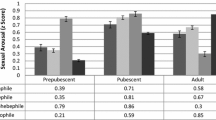Abstract
The Screening Scale for Pedophilic Interests (SSPI; Seto & Lalumière, 2001), a brief measure of sexual attraction to prepubescent children that is based on victim characteristics, was used in two samples of 113 and 145 adult male sex offenders with child victims. In both samples, the SSPI was significantly and positively correlated with an index of phallometrically-measured sexual arousal to stimuli depicting prepubescent children. It was also significantly and positively correlated in both samples with violent recidivism (meaning either nonsexually violent offenses or sexual offenses involving physical contact with a victim), and positively correlated with sexual recidivism, significantly so in the second, larger sample. Focusing on the larger sample, the SSPI added to the predictive accuracy of a measure of general antisociality (the Psychopathy Checklist-Revised), while the phallometric index of sexual arousal did not add predictive accuracy once the other two measures were entered. The SSPI also yielded the same interaction between anomalous sexual interests and psychopathy we had previously reported using phallometric data (Rice & Harris, 1997). These findings suggest that the SSPI has predictive utility among adult male sex offenders with child victims, and accounts for variance in sexual offending that is not explained by phallometric testing.
Similar content being viewed by others
EFERENCES
American Psychiatric Association. (1980). Diagnostic and statisti-cal manual of mental disorders (3rd ed.). Washington, DC: Author.
Barbaree, H. E., Seto, M. C., Langton, C. M., & Peacock, E. J. (2001). Evaluating the predictive accuracy of six risk assessment instruments for adult sex offenders. Criminal Justice and Behavior, 28, 490–521.
Barbaree, H. E., Seto, M. C., & Maric, A. (1995). Sex of-fender characteristics, response to treatment, and correctional release decisions at the Warkworth Sexual Behaviour Clinic (Research Report 1997-73). Prepared for Ministry of the Solicitor-General and Correctional Service of Canada, Ottawa, Ontario.
Blishen, B. R., Carroll, W. K., & Moore, C. (1987). The 1981 socioeconomic index for occupations in Canada. Canadian Review of Sociology and Anthropology, 24, 465–488.
Chaplin, T. C., Rice, M. E., & Harris, G. T. (1995). Salient victim suffering and the sexual responses of child molesters. Journal of Consulting and Clinical Psychology, 63, 249–255.
Doren, D. M. (2002). Evaluating sex offenders: A manual for civil commitment and beyond. Newbury Park, CA: Sage.
Freund, K., & Blanchard, R. (1989). Phallometric diagnosis of pe-dophilia. Journal of Consulting and Clinical Psychology, 57, 100–105.
Freund, K., & Watson, R. (1991). Assessment of the sensitivity and specificity of a phallometric test: An update of phallomet-ric diagnosis of pedophilia. Psychological Assessment, 3, 254–260.
Hanson, R. K. (1997). The development of a brief actuarial risk scale for sexual offense recidivism (User report 1997-04). Ottawa: Department of the Solicitor General of Canada.
Hanson, R. K., & Bussiére, M. T. (1998). Predicting relapse: A meta-analysis of sexual offender recidivism studies. Journal of Consulting and Clinical Psychology, 66, 348–362.
Hanson, R. K., & Thornton, D. (2000). Improving risk assessments for sex offenders: A comparison of three actuarial scales. Law and Human Behavior, 24, 119–136.
Hare, R. D. (2003). The Hare Psychopathy Checklist-Revised (2nd ed.). Toronto, Canada: Multi-Health Systems.
Harris, G. T., Rice, M. E., & Quinsey, V. L. (1993). Violent recidivism of mentally disordered offenders: The development of a statistical prediction instrument. Criminal Justice and Behavior, 20, 315–335.
Harris, G. T., Rice, M. E., Quinsey, V. L., & Chaplin, T. C. (1996). Viewing time as a measure of sexual interest among child molesters and normal heterosexual men. Behaviour Research and Therapy, 34, 389–394.
Harris, G. T., Rice, M. E., Quinsey, V. L., Chaplin, T. C., & Earls, C. (1992). Maximizing the discriminant validity of phallometric assessment data. Psychological Assessment, 4, 502–511.
Harris, G. T., Rice, M. E., Quinsey, V. L., Lalumière, M. L., Boer, D., & Lang, C. (2003). A multi-site comparison of actuarial risk instruments for sex offenders. Psychological Assessment, 15, 413–425.
Heilbrun, K., Ogloff, J. R. P., & Picarello, K. (1999). Dangerous offender statutes in the United States and Canada: Implications for risk assessment. International Journal of Law and Psychiatry, 22, 393–415.
Lalumière, M. L., & Harris, G. T. (1998). Common questions regarding the use of phallometric testing with sexual offenders. Sexual Abuse: Journal of Research & Treatment, 10, 227–237.
Mossman, D. (1994). Assessing predictions of violence: Being accurate about accuracy. Journal of Consulting and Clinical Psychology, 62, 783–792.
Quinsey, V. L., & Chaplin, T. C. (1988). Preventing faking in phallo-metric assessments of sexual preference. Annals of the New York Academy of Sciences, 528, 49–58.
Quinsey, V. L., Harris, G. T., Rice, M. E., & Cormier, C. A. (1998). Violent offenders: Appraising and managing risk. Washington, DC: American Psychological Association.
Quinsey, V. L., Steinman, C. M., Bergersen, S. G., & Holmes, T. F. (1975). Penile circumference, skin conductance, and ranking responses of child molesters and & “normals” to sexual and nonsexual visual stimuli. Behavior Therapy, 6, 213–219.
Rice, M. E., & Harris, G. T. (1997). Cross-validation and extension of the Violence Risk Appraisal Guide for child molesters and rapists. Law and Human Behavior, 21, 231–241.
Seto, M. C., & Barbaree, H. E. (1999). Psychopathy, treatment behavior and sex offender recidivism. Journal of Interpersonal Violence, 14, 1235–1248.
Seto, M. C., & Lalumière, M. L. (2001). A brief screening scale to identify pedophilic interests among child molesters. Sexual Abuse: A Journal of Research and Treatment, 13, 15–25.
Seto, M. C., Lalumière, M. L., & Kuban, M. (1999). The sexual preferences of incest offenders. Journal of Abnormal Psychology, 108, 267–272.
Seto, M. C., Murphy, W. D., Page, J., & Ennis, L. (2003). Detecting anomalous sexual interests among juvenile sex offenders. Annals of the New York Academy of Sciences, 989, 106–118.
Author information
Authors and Affiliations
Rights and permissions
About this article
Cite this article
Seto, M.C., Harris, G.T., Rice, M.E. et al. The Screening Scale for Pedophilic Interests Predicts Recidivism Among Adult Sex Offenders with Child Victims. Arch Sex Behav 33, 455–466 (2004). https://doi.org/10.1023/B:ASEB.0000037426.55935.9c
Issue Date:
DOI: https://doi.org/10.1023/B:ASEB.0000037426.55935.9c




